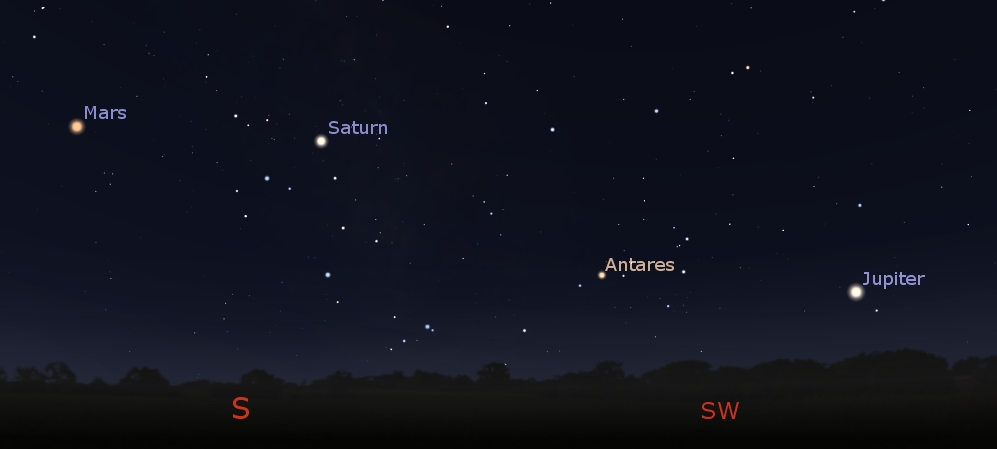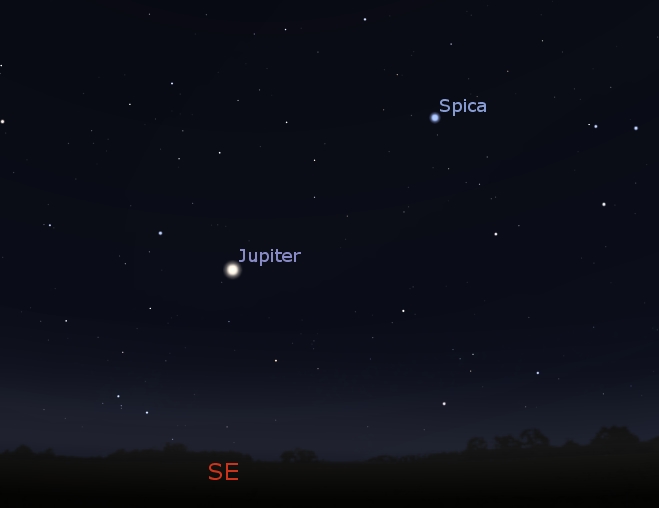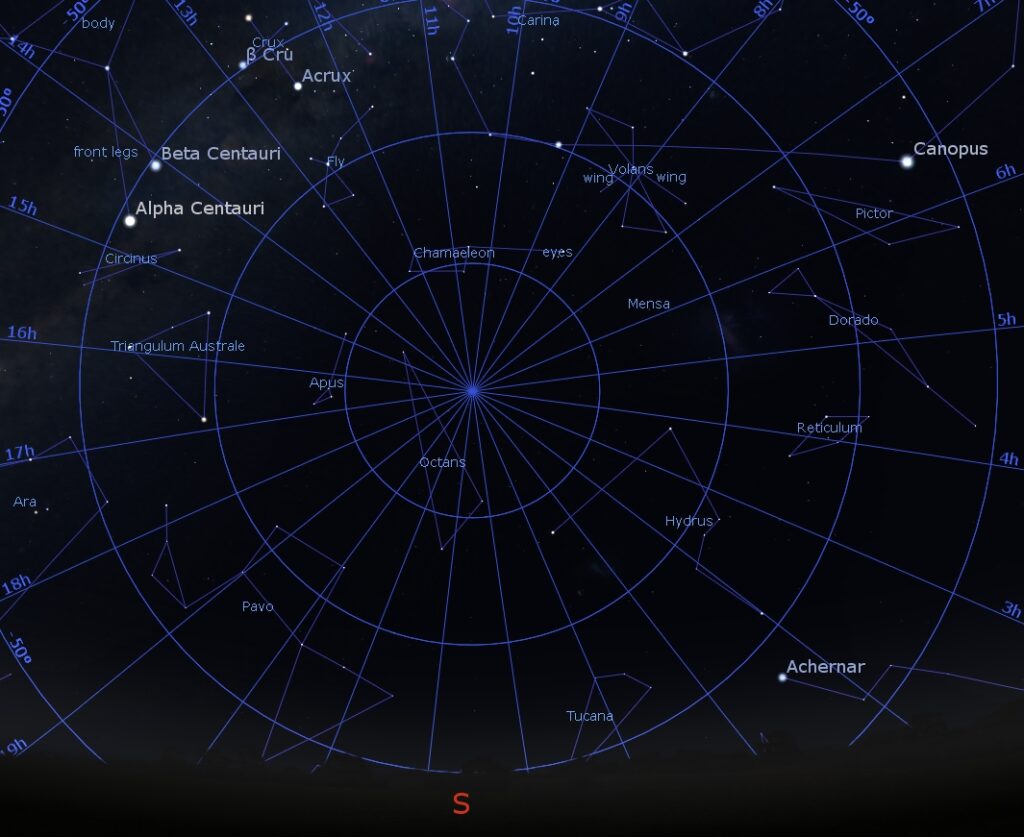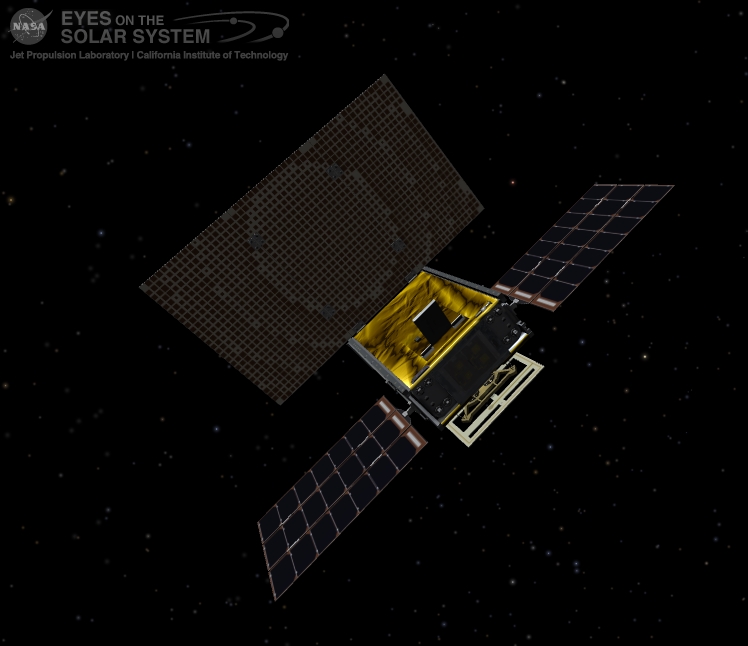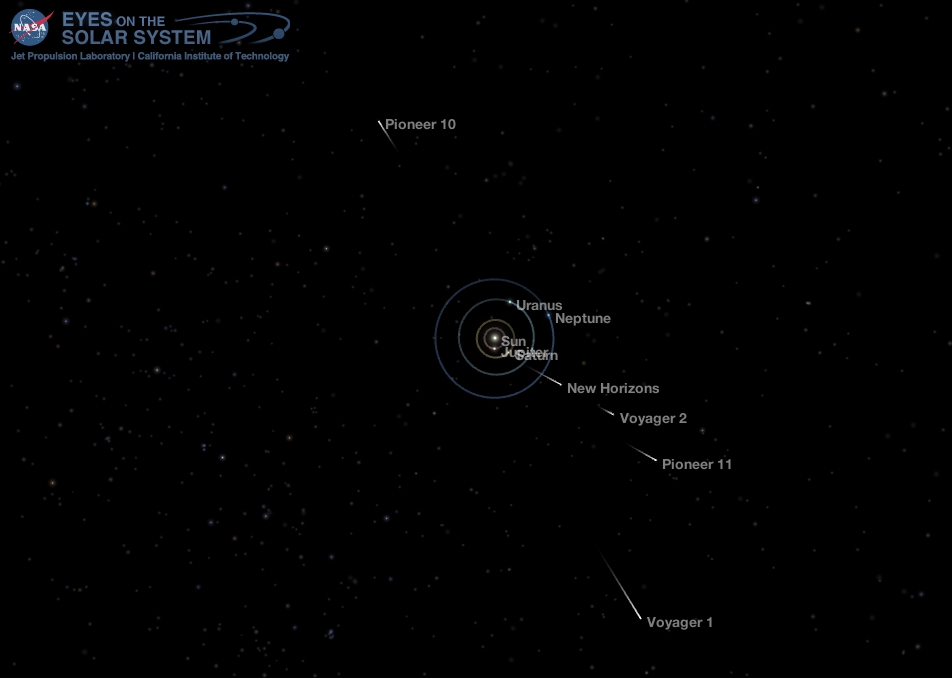Mars and Saturn agree that they rather like the early morning sky, and have decided to stay there forever… or so it seems…
Jupiter just past opposition, is slowly leaving the morning planets and making its way towards being visible only in the evenings.
I was playing with the equatorial grid feature of Stellarium and noticed how close Polaris was to the North Celestial Pole.
So, of course, I HAD to see how the South Celestial Pole looked… and I noticed the the southern hemisphere doesn’t have a convenient star near the pole – which led me to find this article on the One-Minute Astronomer about how to find the South Celestial Pole.
The Moon
The Moon is new on the 15th, and joins Venus in the western sky near sunset as a thin waxing crescent on the 17th. The Moon will be high in the western sky after sunset on the 20th &21st.
The Sun
Although there is some impressive coronal loop activity along the Sun’s equator, the Sun has been spot-free for a day. Coronal holes remain at both poles with a diffuse hole along the equator. The solar wind speed is 357 km/sec, with a density of 4.0 protons/cm3. SpaceWeather.com says: “NOAA forecasters estimate a 60% chance of G1-class geomagnetic storms on May 17th when a stream of solar wind hits Earth’s magnetic field. The gaseous material is flowing from a southern hole in the sun’s atmosphere. High-latitude sky watchers should be alert for auroras and, of course, STEVE.”
Compared to the last few weeks, there have been only a few prominences in the Sun’s chromosphere over the last couple days.
You can create your own time-lapse movies of the Sun here: AIA/HMI Browse Data.
You can browse all the SDO images of the Sun from 2010 to the present here: Browse SDO archive.
Asteroids
Upcoming Earth-asteroid encounters:
We have a close shave on the 15th, as 2010 WC9 passes by the Earth at half the distance of the Moon!
| Asteroid |
Date(UT)
|
Miss Distance
|
Velocity (km/s)
|
Diameter (m)
|
| 1999 LK1 |
2018-May-15
|
13.3 LD
|
10
|
141
|
| 2018 JX1 |
2018-May-15
|
9.4 LD
|
7.7
|
18
|
| 2010 WC9 |
2018-May-15
|
0.5 LD
|
12.8
|
71
|
| 2018 JX |
2018-May-16
|
3.9 LD
|
13
|
77
|
| 2018 JC |
2018-May-17
|
17.7 LD
|
9.4
|
77
|
| 2018 GL1 |
2018-May-18
|
14.3 LD
|
5.2
|
69
|
| 2018 JL2 |
2018-May-19
|
10.9 LD
|
13.5
|
40
|
| 2018 JG1 |
2018-May-20
|
5.3 LD
|
8.3
|
44
|
| 2018 JK |
2018-May-22
|
16.3 LD
|
12.5
|
81
|
| 2018 JG2 |
2018-May-25
|
18.5 LD
|
6.9
|
62
|
| 68347 |
2018-May-29
|
9.5 LD
|
13.3
|
389
|
| 2013 LE7 |
2018-May-31
|
17.8 LD
|
1.7
|
12
|
| 2018 EJ4 |
2018-Jun-10
|
5.6 LD
|
6.2
|
195
|
| 2015 DP155 |
2018-Jun-11
|
9 LD
|
4.4
|
170
|
| 2017 YE5 |
2018-Jun-21
|
15.6 LD
|
15.5
|
513
|
| 467309 |
2018-Jun-23
|
17.9 LD
|
14
|
355
|
| 441987 |
2018-Jun-24
|
7.3 LD
|
12.6
|
178
|
Notes: LD means “Lunar Distance.” 1 LD = 384,401 km, the distance between Earth and the Moon. Table from SpaceWeather.com
Near-Earth objects (NEOs) discovered this month: 48, this year: 681, all time: 18234.
Potentially hazardous asteroids: 1907 (as of May 15, 2018)
Minor Planets discovered: 774,880 (as of May 15, 2018)
Fireballs
On May 14, 2018, the NASA All Sky Fireball Network reported 7 fireballs.
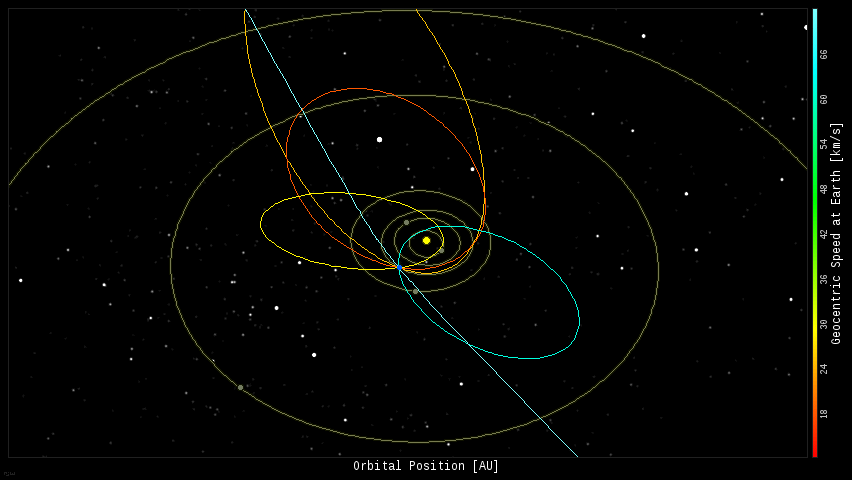 In this diagram of the inner solar system, all of the fireball orbits intersect at a single point–Earth. Source: Spaceweather.com
In this diagram of the inner solar system, all of the fireball orbits intersect at a single point–Earth. Source: Spaceweather.comThe Solar System
This is the position of the planets in the solar system:
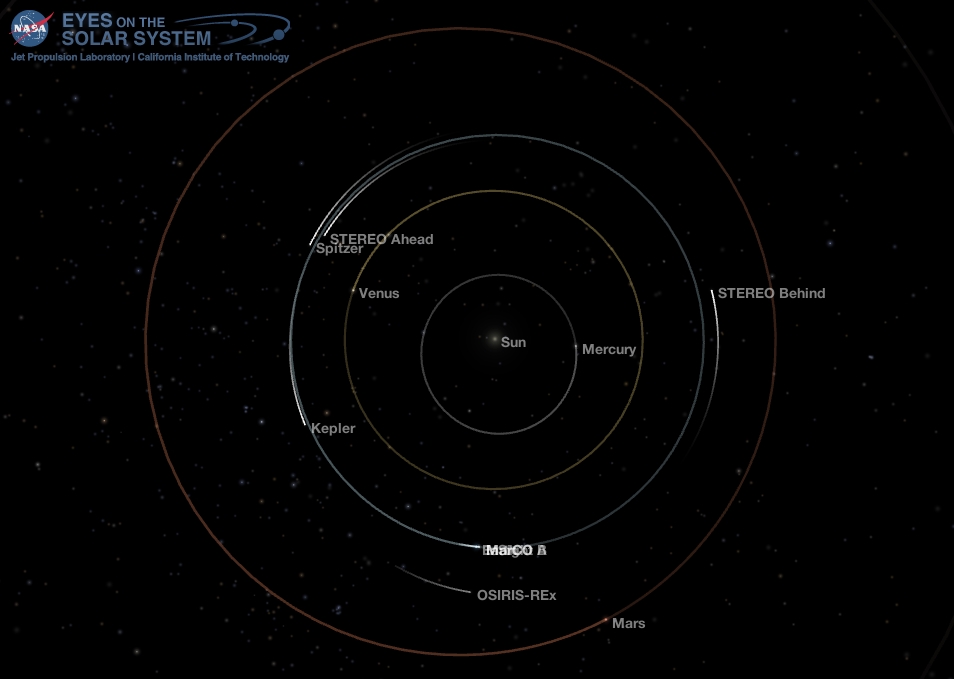 Position of the planets in the inner solar system, May. 15, 2018. Credit: NASA Eyes on the Solar System / Bob Trembley.
Position of the planets in the inner solar system, May. 15, 2018. Credit: NASA Eyes on the Solar System / Bob Trembley.You may note the mess of text where the Earth should be – this is because of the InSight and MarCO A&B spacecraft.
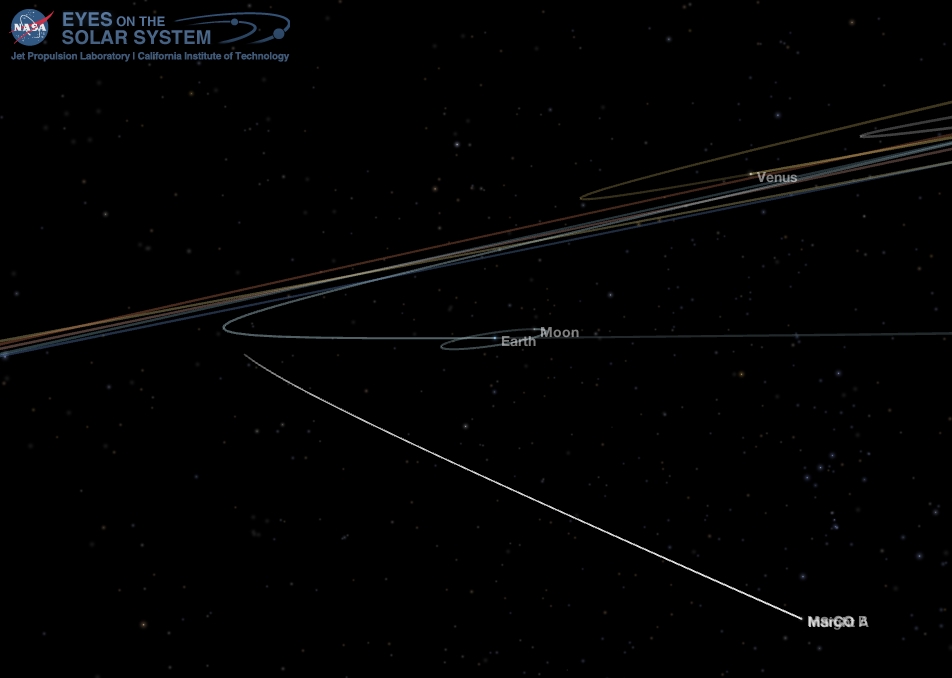 Position of the MarCO A & B and the InSight spacecraft, May. 15, 2018. Credit: NASA Eyes on the Solar System / Bob Trembley.
Position of the MarCO A & B and the InSight spacecraft, May. 15, 2018. Credit: NASA Eyes on the Solar System / Bob Trembley.The MarCO A&B are cubesats that are flying in tandem with the InSight spacecraft.
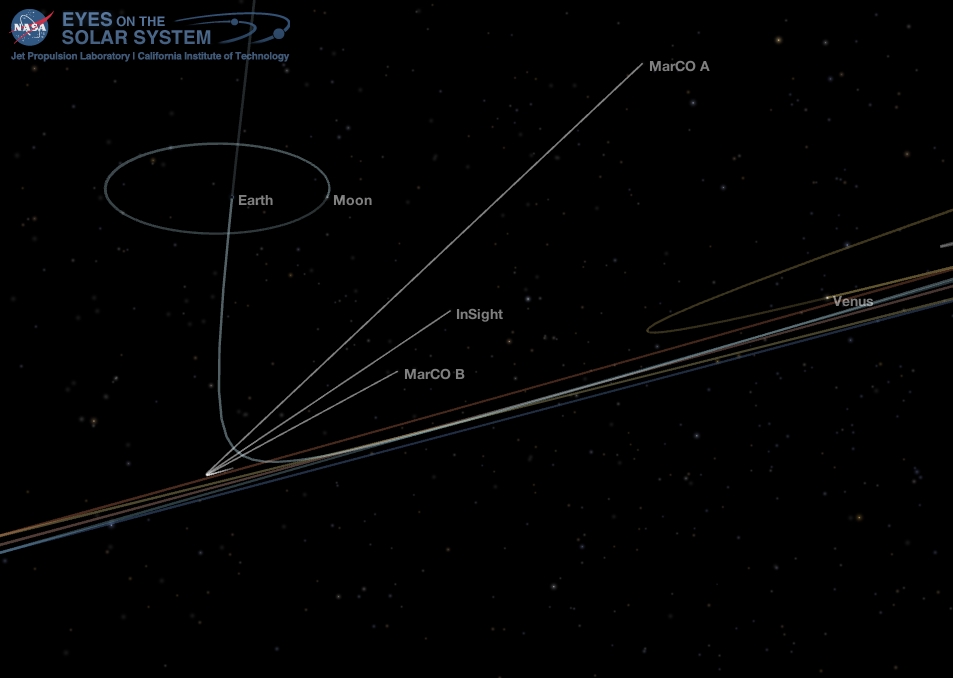 Closer view showing spread of the MarCO A & B and the InSight spacecraft, May. 15, 2018. Credit: NASA Eyes on the Solar System / Bob Trembley.
Closer view showing spread of the MarCO A & B and the InSight spacecraft, May. 15, 2018. Credit: NASA Eyes on the Solar System / Bob Trembley.The MarCo spacecraft are technology demonstrations; they will transmit telemetry back to Earth as the InSight lander descends towards Mars’ surface.
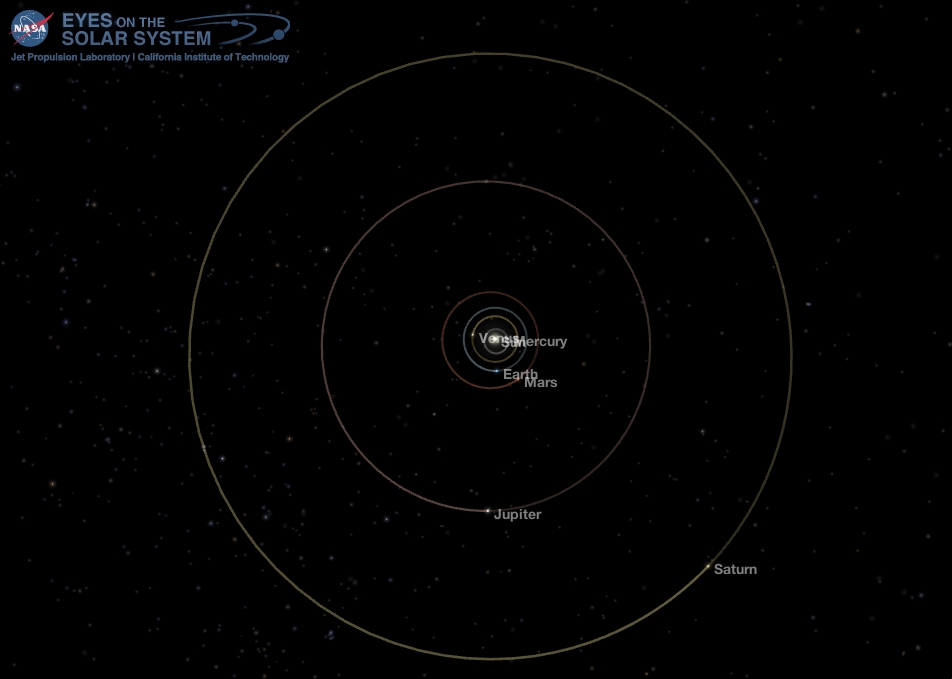 Position of the planets in the middle solar system, May. 15, 2018. Credit: NASA Eyes on the Solar System / Bob Trembley.
Position of the planets in the middle solar system, May. 15, 2018. Credit: NASA Eyes on the Solar System / Bob Trembley.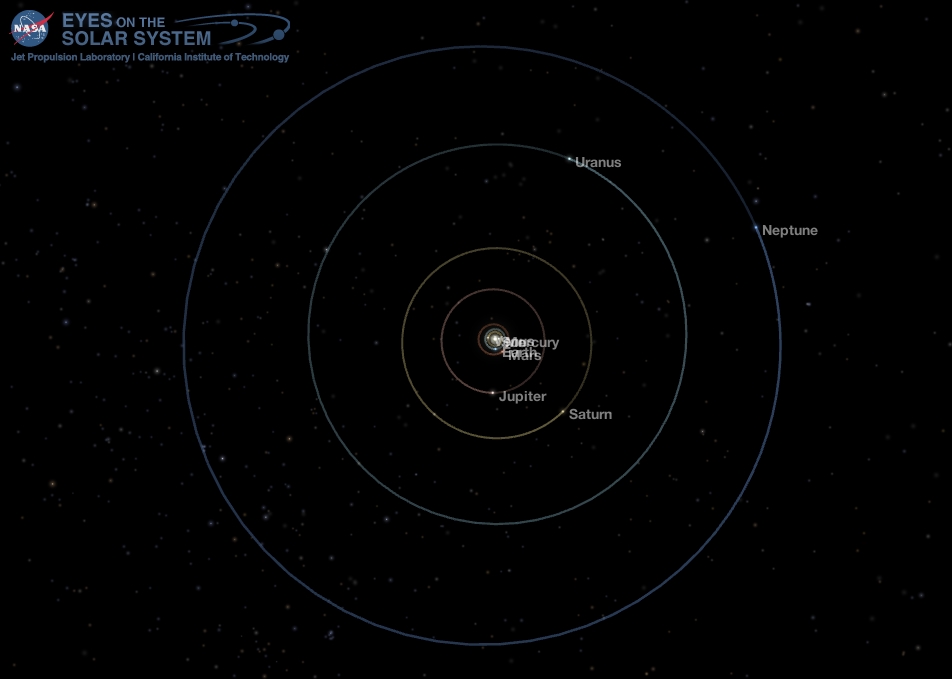 Position of the planets in the outer solar system, May. 15, 2018. Credit: NASA Eyes on the Solar System / Bob Trembley.
Position of the planets in the outer solar system, May. 15, 2018. Credit: NASA Eyes on the Solar System / Bob Trembley.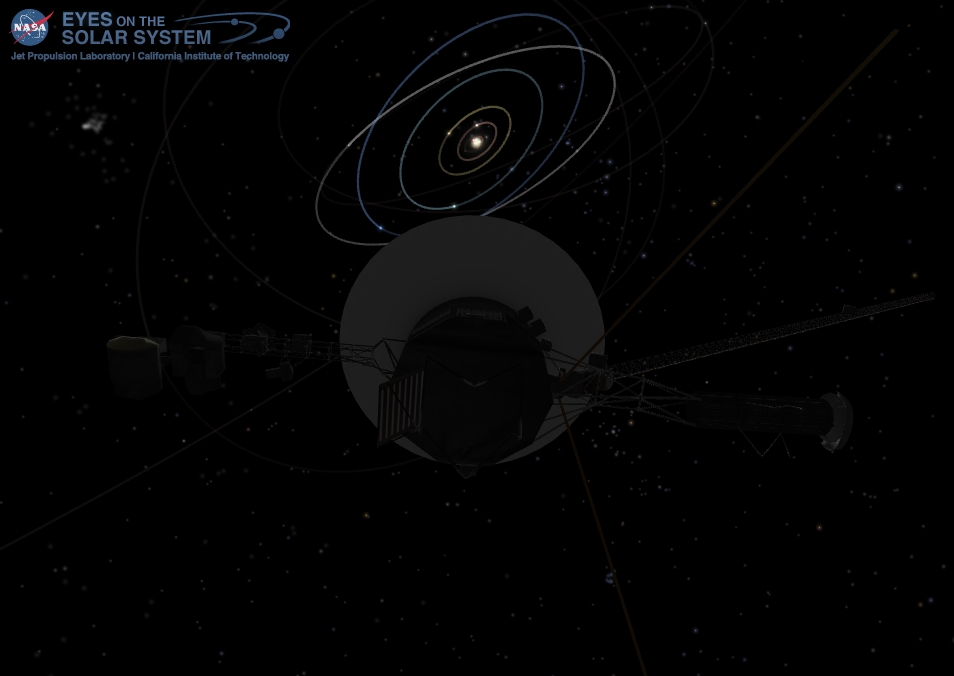 Voyager 1, looking back towards the Sun, May. 15, 2018. Credit: NASA Eyes on the Solar System / Bob Trembley.
Voyager 1, looking back towards the Sun, May. 15, 2018. Credit: NASA Eyes on the Solar System / Bob Trembley.Exoplanets
Confirmed Exoplanets: 3,725 (4/26/2018)
Multi-Planet Systems: 613 (4/26/2018)
Kepler Candidate Exoplanets: 4,496 (8/31/2017)
TESS Candidate Exoplanets: 0
Data from the NASA Exoplanet Archive
Apps used for this post:
Stellarium: a free open source planetarium app for PC/MAC/Linux. It’s a great tool for planning observing sessions.
NASA Eyes on the Solar System: an immersive 3D solar system and space mission simulator – free for the PC /MAC. I maintain the unofficial NASA Eyes Facebook page.
